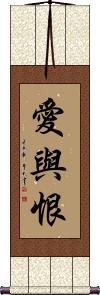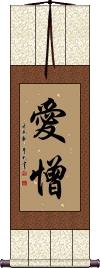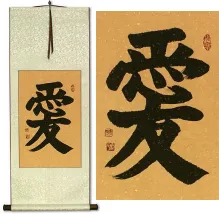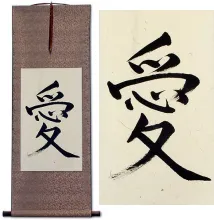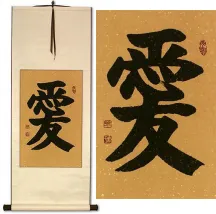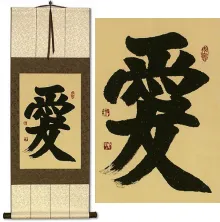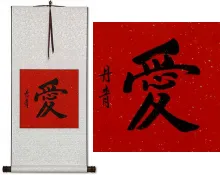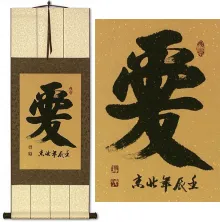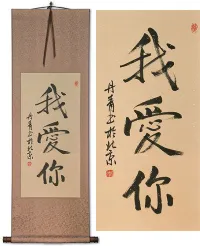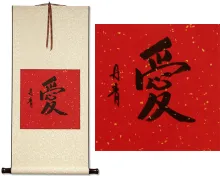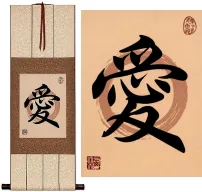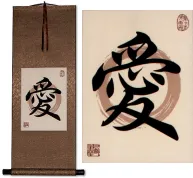Many custom options...
And formats...

Love and Hate in Chinese / Japanese...
Buy a Love and Hate calligraphy wall scroll here!
Personalize your custom “Love and Hate” project by clicking the button next to your favorite “Love and Hate” title below...
Love and Hate
Whether you want to make a joke about what marriage really is or just feel that the world is full of love and hate, this selection is for you.
愛與恨 happens to literally translate. So the first character is love. The middle character is a connecting particle-like “and” in English. The last character is hate.
Upon request, we can omit the “and” character and just put a dot to separate love and hate if you prefer.
Love and Hate
愛憎 is a weird selection for a calligraphy wall scroll. But if you really want it, we'll do it.
This version is most appropriate if your audience is Japanese or Korean (for Koreans who can read the ancient Korean Hanja).
The first character means love or affection.
The second character means hate, dislike, detest, or loathe.
This in-stock artwork might be what you are looking for, and ships right away...
Gallery Price: $87.50
Your Price: $39.00
Gallery Price: $65.00
Your Price: $39.88
Gallery Price: $65.00
Your Price: $39.88
Gallery Price: $200.00
Your Price: $122.88
Not the results for Love and Hate that you were looking for?
Below are some entries from our dictionary that may match your Love and Hate search...
| Characters If shown, 2nd row is Simp. Chinese |
Pronunciation Romanization |
Simple Dictionary Definition |
愛憎 爱憎 see styles |
ài zēng ai4 zeng1 ai tseng aizou / aizo あいぞう |
More info & calligraphy: Love and Hatelove and hate Love and hate, desire and dislike. |
四無量心 四无量心 see styles |
sì wú liàng xīn si4 wu2 liang4 xin1 ssu wu liang hsin shi muryōshin |
More info & calligraphy: Brahmavihara - The Four Immeasurables |
七情 see styles |
qī qíng qi1 qing2 ch`i ch`ing chi ching shichijou / shichijo しちじょう |
seven emotional states; seven affects of traditional Chinese medical theory and therapy, namely: joy 喜[xi3], anger 怒[nu4], anxiety 憂|忧[you1], thought 思[si1], grief 悲[bei1], fear 恐[kong3], fright 驚|惊[jing1]; seven relations (1) seven emotions (in The Book of Rites: joy, anger, sorrow, fear, love, hate, desire); seven emotions (in Buddhism: joy, anger, sorrow, pleasure, love, hate, desire); (2) seven effects (of a traditional Chinese medicine); (surname) Shichijō The seven emotions : pleasure, anger, sorrow, joy, love, hate, desire. |
三惑 see styles |
sān huò san1 huo4 san huo sanwaku; sannaku さんわく; さんなく |
{Buddh} three mental disturbances A Tiantai classification of the three delusions, also styled 三煩惱; 三漏; 三垢; 三結; trials or temptations, leakages, uncleannesses, and bonds. The first of the following three is common to all disciples, the two last to bodhisattvas. They arise from (a) 見, 思, 惑 things seen and thought, i.e. illusions from imperfect perception, with temptation to love, hate, etc.; to be rid of these false views and temptations is the discipline and nirvāṇa of ascetic or Hīnayāna Buddhists. Mahāyāna proceeds further in and by its bodhisattva aims, which produce their own difficulties, i.e. (b) 塵沙惑 illusion and temptation through the immense variety of duties in saving men; and (c) 無明惑 illusions and temptations that arise from failure philosophically to understand things in their reality. |
三想 see styles |
sān xiǎng san1 xiang3 san hsiang sansō |
The three evil thoughts are the last, desire, hate, malevolence; the three good thoughts are 怨想 thoughts of (love to) enemies, 親想 the same to family and friends, 中人想 the same to those who are neither enemies nor friends, i.e. to all; v. 智度論 72. |
三毒 see styles |
sān dú san1 du2 san tu sandoku さんどく |
{Buddh} (See 煩悩・2) the three kleshas that poison the heart of man (desire, ill will and ignorance) The three poisons, also styled 三根; 三株; they are 貪 concupiscence, or wrong desire, 瞋 anger, hate, or resentment, and 痴 stupidity, ignorance, unintelligence, or unwillingness to accept Buddha-truth; these three are the source of all the passions and delusions. They represent in part the ideas of love, hate, and moral inertia. v. 智度論 19, 31. |
九結 九结 see styles |
jiǔ jié jiu3 jie2 chiu chieh kyūketsu |
The nine bonds that bind men to mortality: love, hate, pride, ignorance, (wrong)views, possessions (or grasping), doubt, envy, meanness (or selfishness). They are the 六隨眠 plus grasping, envy, and meanness. |
八苦 see styles |
bā kǔ ba1 ku3 pa k`u pa ku hakku はっく |
the eight distresses - birth, age, sickness, death, parting with what we love, meeting with what we hate, unattained aims, and all the ills of the five skandhas (Buddhism) {Buddh} the eight kinds of suffering (birth, old age, disease, death, parting from loved ones, meeting disliked ones, not getting what one seeks, pains of the five skandha) The eight distresses―birth, age, sickness, death, parting with what we love, meeting with what we hate, unattained aims, and all the ills of the five skandhas. |
六気 see styles |
rokki; rikki; rikuki ろっき; りっき; りくき |
(1) yin, yang, wind, rain, darkness, light; (2) cold, heat, dryness, dampness, wind, fire; (3) six emotions (joy, anger, sorrow, pleasure, love, hate) |
心所 see styles |
xīn suǒ xin1 suo3 hsin so shinjo しんじょ |
{Buddh} mental functions; mental factors; mental states (心所法) Mental conditions, the attributes of the mind, especially the moral qualities, or emotions, love, hate, etc.; also 心所有法, v. 心心. |
恩讎 see styles |
onshuu / onshu おんしゅう |
love and hate |
恩讐 see styles |
onshuu / onshu おんしゅう |
love and hate |
愛恚 爱恚 see styles |
ài huì ai4 hui4 ai hui aii |
Love and hate, desire and hate. |
憎愛 憎爱 see styles |
zēn gài zen1 gai4 tsen kai zōai |
Hate and love. |
七種捨 七种舍 see styles |
qī zhǒng shě qi1 zhong3 she3 ch`i chung she chi chung she shichishu sha |
Seven abandonments or riddances―cherishing none and nothing, no relations with others, riddance of love and hate, of anxiety about the salvation of others, of form, giving to others (e.g. supererogation), benefiting others without hope of return. Another form is―cherishing nothing, riddance of love and hate, of desire, anger, etc., of anxiety about, etc., as above. |
六著心 六着心 see styles |
liù zhāo xīn liu4 zhao1 xin1 liu chao hsin roku jaku shin |
(六著) The six bonds, or the mind of the six bonds: greed, love, hate, doubt, lust, pride. |
愛憎劇 see styles |
aizougeki / aizogeki あいぞうげき |
love-hate relationships drama (movie, etc.) |
一相三昧 see styles |
yī xiàng sān mèi yi1 xiang4 san1 mei4 i hsiang san mei ichisō zanmai |
A state of samādhi in which are repressed hate and love, accepting and rejecting, etc., and in which the mind reaches an undivided state, being anchored in calm and quiet. |
因愛成恨 因爱成恨 see styles |
yīn ài chéng hèn yin1 ai4 cheng2 hen4 yin ai ch`eng hen yin ai cheng hen |
hatred caused by love (idiom); to grow to hate someone because of unrequited love for that person |
好逸惡勞 好逸恶劳 see styles |
hào yì wù láo hao4 yi4 wu4 lao2 hao i wu lao |
to love ease and comfort and hate work (idiom) |
愛恨交加 爱恨交加 see styles |
ài hèn jiāo jiā ai4 hen4 jiao1 jia1 ai hen chiao chia |
to feel a mixture of love and hate |
愛恨交織 爱恨交织 see styles |
ài hèn jiāo zhī ai4 hen4 jiao1 zhi1 ai hen chiao chih |
mixture of love and hate |
愛憎関係 see styles |
aizoukankei / aizokanke あいぞうかんけい |
love-hate relationship |
月愛三昧 月爱三昧 see styles |
yuè ài sān mèi yue4 ai4 san1 mei4 yüeh ai san mei getsuai zanmai |
A Buddha's 'moon-love samādhi' in which he rids men of the distresses of love and hate. |
相愛相殺 相爱相杀 see styles |
xiāng ài xiāng shā xiang1 ai4 xiang1 sha1 hsiang ai hsiang sha |
to have a love-hate relationship with each other |
Variations: |
onshuu / onshu おんしゅう |
love and hate |
愛憎相半ばする see styles |
aizouainakabasuru / aizoainakabasuru あいぞうあいなかばする |
(exp,vs-s) to have mixed feelings of love and hatred; to love and hate equally |
Variations: |
onshuu / onshu おんしゅう |
love and hate |
可愛さ余って憎さ百倍 see styles |
kawaisaamattenikusahyakubai / kawaisamattenikusahyakubai かわいさあまってにくさひゃくばい |
(expression) (proverb) the greatest hate proceeds from the greatest love |
The following table may be helpful for those studying Chinese or Japanese...
| Title | Characters | Romaji (Romanized Japanese) | Various forms of Romanized Chinese | |
| Love and Hate | 愛與恨 爱与恨 | ài yǔ hèn ai4 yu3 hen4 ai yu hen aiyuhen | ai yü hen aiyühen |
|
| Love and Hate | 愛憎 爱憎 | ai zou / aizou / ai zo | ài zèng / ai4 zeng4 / ai zeng / aizeng | ai tseng / aitseng |
| In some entries above you will see that characters have different versions above and below a line. In these cases, the characters above the line are Traditional Chinese, while the ones below are Simplified Chinese. | ||||
Successful Chinese Character and Japanese Kanji calligraphy searches within the last few hours...
